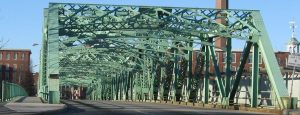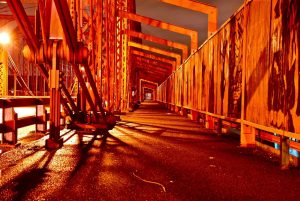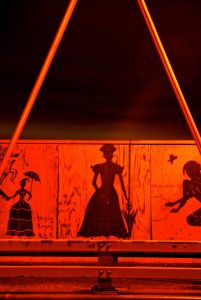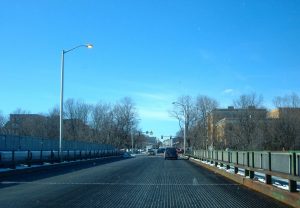The following is a cross-post from my own blog (PaulMarion.com) on January 4, 2021. It took more than a year, but I compiled the best comments from a discussion thread on social media provoked by a question I threw out to the crowd. With winter giving up its last snows and freezes, this is a good time to share the material on RichardHowe.com. On February 13, 2019, I asked friends on Facebook if they knew the name of wooden panels that for decades were installed in the late fall on city bridges in Lowell, Mass., to shield pedestrians from snow and wind in the months ahead. I once knew the name, but had since forgotten. By the end of the day, the dialogue had 165 comments by dozens of people.
Excerpts from the discussion thread, slightly edited for easier reading, are presented unsigned to emphasize the collaborative effort to answer the question and accept the result. Contributors are acknowledged at the end. My apology to anyone whose name slipped by. Joe Donahue of Lowell and Duke University called the resulting composition a group poem. Special thanks to Greg Marion, a far-flung cousin of mine, for the photographs.—PM
Question for Lowell folks. Asking for a friend. What is the name of the wooden panels that used to be installed on city bridges to protect pedestrians from snow and high winds? Storm boards? Snow barriers? The Dept. of Public Works had a name for those panels.
I wrote a newspaper story about the ones at Pawtucket Falls decades ago, and I think they were called flashboards.
No, flashboards are on top of the stone dam used to keep water high and flowing into the canal there.
Was it wind something? Wind barriers? Wind breaks?
Speaking of Lowellisms, the mounds of snow are called “snow bankins” instead of snow embankments.
Is “bankin” a Lowellism, and how is it spelt? I just now realized it means “embankment.”
“Bankin,” n., North of Boston. Embankment. The septic tank is at the top of the bankin, the leach field is below it.
Yup. The bankin was what the kids in Dracut said when we first moved there as kids. I thought it was weird.
Are you looking for what people called the wood? There was a name for the panels used by local people, something like storm barriers, but that’s not it. I thought it would be easy to get the answer. People don’t seem to have it.
Me and my father say wind breakers. Thought they were ugly and useless and hated it when the City forgot to take them down.
Often painted gray.
Except for a few years recently when black silhouettes were stenciled on them. People in Victorian outfits.
Storm boards rings a bell.
How about “smutters,” an invented word?
I remember when the boards had silhouettes of Victorian figures on them.
“Stohm Bahrias.”
1920s Lowell Textile School Alumni Association newsletter called them wind boards.
Thanks for the research. How the heck did you track it down? We have a minor trend for boards.
Just a simple Google Advanced Search with keywords wind + boards + Lowell. Also tried wind boards and storm boards. Love this thread.
Of course, a scientific inquiry. I’m amazed it came up. Someone has to write about this, you or me or anybody on this thread. This is folklore, the lingo of River People, what we call stuff by custom.
Have we got a winner?
I remember those. Someone in City Hall must know. Can they make a ruling?
I’ve been racking my brain. I just came up with wind blocks. Wind shields?
City of Lowell spokesperson says wind barriers. Does not sound familiar to me.
I’m going with storm boards.
I think storm boards.
My dad was a cop in the city. He called them storm boards.
A second opinion from City Hall: storm guards.
You’re over-thinking it. Just go with boards.
What about storm barriers?
A lifelong bridge-crosser must know the answer.
I remember them being called wind panels because they were put up on the windy side of the bridge.
Wind panels seems too technical a term for people talking about this in a diner with winter coming.
Panels is a smart word.
The storm boards were like the first robin in the spring, except for winter.
When I was eight years old, I would take the bus to go downtown, from the Highlands, every Saturday morning, for my clarinet lesson in the Lowell High School basement and then walk over the Bridge Street Bridge to spend the weekend with my grandparents. My Gramps called them “the storm boards,” and they made a huge difference while crossing the Merrimack River in winter months. Those winds were STRONG, but of course I was little. I still call them storm boards and so did my grandmother who walked across the bridge daily.
I keep hearing “storm boards” in my head.
At the club, the members would talk about the wind panels, in French: panneau de vent.
To protect “the walkers.” I love that term. We had “walkers” in elementary school. They got to leave before the bus kids. “Line up,” the nuns would say. “Walkers in front, two by two.” Ring the bell, and they’re off.
Boards. In the Heritage Partnership article: “Boards went up each winter to protect pedestrians from cold blowing winds.”
I loved how the boards went up on the Moody St. bridge on the west side, when all the college students hiked over on the east side.
My uncle Ray was in charge of getting those up. He had an office way up in City Hall. Nice view.
What did he call them?
Went to the grave with him.
Some people.
Storm boards. Happy Valentine’s Day.
That’s what my Gramps called them, and he was one of the smartest people I have ever known.
I campaigned on bringing back the wind barriers when I ran for City Council. Downtown needs more foot traffic coming across the river from Bridge St.
Bring back the bridge boards!
For several years the City workers reused one gray panel on the Moody or Textile or University Avenue bridge that had graffiti on it that read “We Luv You David Jo,” which must have been spray-painted by someone who went to a New York Dolls concert on campus.
Those boards kept the kids from Ste. Jeanne d’Arc parish from being blown into the falls whilst walking to St. Joseph High School.
Lowell Sun, April 2, 1952, p. 6: “It seems only a short time ago that we were urging here that storm boards be erected on the various bridges throughout Lowell. And now it’s just about time they came down. The proverbial March winds have blown their last, and the almanac tells us that mild April showers are now in store for us. The storm boards certainly serve a worthy purpose in preventing snow drifts during the winter. We have traveled throughout New England and have seen storm boards on only a few bridges.”
1952. Storm boards. How great is this? Super research.
We always just said, “The boards are up.”
I called them: “I walked the Bridge Street Bridge to high school past the wind boards.”
Wind breakers!
Weren’t they called wind screens?
Windscreen is a British word for a car windshield.
Somebody else said storm guards. Or snow guards.
This could show up on Jeopardy.
The Lowell Public Works Department called me and said the name is wind barriers, which have not been used for at least fifteen years.
Wow. OK. That sounds official. It’s not what I remember, but I accept the answer. Thanks.
I love this. You should do this once a week. Make it a challenge to identify things in Lowell.
I’ll think of something for next week.
Stuff you know but can’t name.
I’m going with storm boards even if it is not accurate.
Storm boards sounds best to me. I’d buy something that sounds better if it comes from the city’s ancient and honorable sources.
Maybe there was an official name within City Hall but people used another term by custom. Not the first time.
I believe it was boards and don’t think barriers was a term used by real people.
This is about the ways in which we all remember stuff that is mostly community talk and not things written down: traditions, customs, local lore.
This is the coolest thread. A 1920s reference also. There’s the official designation and the popular history from those who crossed the bridge every day. I think of them as being on the Bridge Street Bridge or Cox Bridge. Were they on the Aiken Street Bridge, too, the Ouellette Bridge?
In their heyday, the storm boards were on all the bridges, four bridges from Mammoth Road to Bridge Street.
Say what you want about the storm boards, just don’t forget the “wrinkly tar sidewalk” on Riverside Street.
You’re going deep into Lowell Mythology now, all the subterranean secrets in the Dracut diorite under the topsoil full of mammoth femurs and arrowheads and colonial coins.
Speaking of subterranean, the Richardson Farm on Mammoth Road in Dracut connects with the Pawtucketville neighborhood in Lowell by way of old granite quarries and catacombs.
I’m going with storm boards.
Thanks to Pat Cook, Jamie Patrick Lewis, Joe Boyle, Mike Casey, Diane West, Joan d’Arc, Greg Marion, Susan April, Christina Nikitopoulos, Theresa O’Beirne Barr, Karen O’Beirne, Lynne Lupien, George Proakis, Donna Spellissy, Martha Hayden Burns, Patti Kirwin-Keilty, Brenda O’Brien, Henri Marchand, Sean Thibodeau, Marie Sweeney, Joe Smith, Dick Kenney, Russ Vivier, Marie Louise St. Onge, James Koumpouras, Stephen Conant, Paul Trudel, David Blackburn, Corey Sciuto, Dave Ouellette, Susan Sadlier Hrastinski, Curtis LeMay, Peter Aucella, Martha Mayo, Joseph Donahue, and Pauline Golec.




Yes, this is a community poem. Deeply Lowellian, yet universal. Thank-you, Paul and all! My favorite line is “I believe it was boards and don’t think barriers was a term used by real people.” because I can just hear someone saying that at the long bar at the Worthen over a beer and chaser. And everyone chimes in.
Thanks for your part in this, Susan April, both as researcher and fan of the local talk.